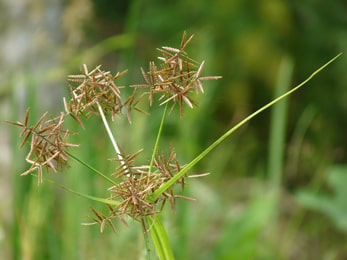Mustaka (Cyperus rotundus) – Practical Uses, Benefits and Dosage

Description of the Plant
Mustaka is present in Indian culture since ancient times. It had been cultivated on high levels in ancient India. It is also known with the name of Cyperus rotundus which is its scientific name. Its common name is nut grass. Mustaka has very huge network of underground slender, creeping and scaly rhizomes which has a bulbous base, arise from a single tuber. This can be 1 to 3 cm in length. The tubers are of blackish brown colour. These are of oblong, ovate shape with a characteristic fragrance. These are red white from inside. The stem of the plant is about 25 cm tall. The leaves are of dark green color and emerging linearly with a grooved upper surface having no ligules or auricles. The flowers of the plant are of red brown color. The nut of the Mustaka is of yellow color, oblong and ovate, having three angles and become black on ripe.
General Description
Mustaka is cultivated in India from very old times. This super bulb has been used for the treatment of numerous illnesses. The scientific and botanical name of Mustaka is Cyperus rotundus. This belongs to Cyperaceae family.
Its description of it is often found in ancient texts. Vagbhata cherish this herb for any kind of fever. He also mentioned it as dipaniya (an appetizer) and pacaniya (digestant). Maharishi charaka also cherish it as thirst relieving and anti-pruritic herb.
It is indigenous to India, but now found in various temperate, tropical and sub-tropical regions.
This plant shows contraceptive, demulcent, emmenagogue, analgesic, astringent, antispasmodic, antibacterial, carminative, emollient, febrifuge, immune-stimulant, laxative, stimulant, tonic, vermifuge, anti-candida, anti-inflammatory, anti-diabetic, anti-diarrheal, cyto-protective, anti-mutagenic, antibacterial and antioxidant properties.
The plant contains various chemicals such as components like Monoterpene hydrocarbon (like Camphene, Limonene, p-Cymene, Sabinene, α-Pinene and β-Pinene), Oxygenated monoterpenes derivatives (like 1,8-Cineole, Terpinen-4-ol, α-Terpineol, Carvacrol, Borneol, Myrtenol and Thymol), Oxygenated sesquiterpenes like (α-Cadinol, (2E,6E)-Farnesol, α-Cyperone, T-Muurolol, Elemol and Caryophyllene oxide.
Classification
- Kingdom – Plantae
- Subkingdom – Tracheobionta
- Super division – Spermatophyta
- Division – Magnoliophyta
- Class – Liliopsida
- Subclass – Commelinidae
- Order – Poales
- Family – Cyperaceae
- Genus – Cyperus
- Species – Rotundus
Habitat
It is extensively distributed due to its ability to adapt wide range of soil types, temperatures, soil pH, altitudes and moisture levels. This plant grows in small clumps up to 100cm high. It is the native of India. Mustaka is found mostly all over the India, also in tropical and subtropical regions of Africa, southern Asia, southern and central Europe.
Names of the Mustaka
- Sanskrit name – Mustaka, Krodeshta, Hima, Varida, Megha, Raja Kaseruka, Abda, Ambhoda
- Latin name – Cyperus rotundus
- English name – Nutgrass, Purple Nutsedge, Java-grass, Coco-grass, Sweet Cyperus
- Hindi name – Motha, nagarmotha
- Tamil name – Korai kilangu
- Telugu name – Bhadra-tunga-mustalu
- Manipuri name – Shembang kouthum
- Marathi name – Barik motha, Bimbal, Nagarmotha
- Malayalam name – Muttanga
- Kannada name – Tunge-gadde
- Gujarati name – Motha
- Bengali name – Mutha, Badhail, Bedalle, Dila Motha, Nagarmuta
- Oriya name – Mutha
- Bangladesh name – Motha
- Sri Lanka name – Kalanthi
- Swedish name – Nötag
- Thailand name – Yaa haeo muu, Yaa khon muu
- Turkish name – Topalak
- Urdu name – Sad kufi, Habu-ul-zillam, Nagarmotha, Dheela, Mork, Motha
- Assamese name – Keyabon
- Brazil name – Alho-bravo, Capim-alho, Capim-dandá, Tiririca, Tiriricavermelha
- Burma name – Monhnyin-bin
- Indonesia name – Teki
- Iraq name – Oyarslan
- Italian name – Zigolo infestante, Cipero orientale, Cipero rotondo, Stancia
- Japanese name – Hamasuge
- Mexican name – Cebollin, Pimientillo
- Myanmar name – Monhnyin-bin
- French name – Herbe-à-oignon, Souchet à tubercules, Souchet rond, Souchet d’Asie,
- German name – Rundes Zypergras, Knolliges Zypergras
- Greece name – Kupere
- Peru name – Coco, Coquillo, Coquito
- Philippines name – Mutha, Ahos-ahos, Boto-botones, Balisanga, Mutha, Sur-sur
Ayurvedic Properties
| Hindi / Sanskrit | English | ||
| Rasa | Kashaya, Tikta, Katu | Taste | Astringent, Bitter, Pungent |
| Guna | Laghu, Rooksha | Physical Property | Light, Dry |
| Virya | Sheeta | Potency | Cold |
| Vipaka | Katu | Metabolic Property (After Digestion) | Pungent |
Effects on Doshas
It balances kapha and pitta.
Classical Categorization
| Charak Samhita | Sushruta Samhita | Vagbhata |
|
|
|
Ancient Verse of Mustaka

The Bhavprakash nighantu edition of 1998: verse 92-94, page no-243.
It states the names and properties of mustaka. The Sanskrit names of mustaka are Mustak, musta, varidnamakam and kuruvinda. Other type of mutha known as nagarmutha.
It is pungent, bitter and astringent in taste. It is cold in potency, promotes digestive fire and manages kapha pitta diseases, blood impurities, thirst, fever, anorexia and wounds.
References
The Bhavprakash nighantu with elaborated Hindi commentary by Padmashri prof. K.C. Chunekar, edited by Dr. G.S. Pandey: Edition of 1998, verse 92-94, page no.243.
Practical uses of Mustaka
- It is acts as analgesic, astringent, antispasmodic, antibacterial, carminative, emollient, anti-inflammatory, anti-diabetic, anti-oxidant and more. It shows effect on various ailments.
- Mustaka is used in treating skin diseases ailments like eczema, scabies and itching.
- Helpful in treating eye disorders such as eye pains, redness of eye, conjunctivitis and ocular discharges.
- Helps to burn fat so helps to reduce fat deposition in obese people.
- Enhances the size of the breast.
- Normalizes the menstrual problems like irregularities.
- Improves digestive system, removes toxins and worms from gastrointestinal tract and purifies the blood.
- Treats ulcers.
- It is a nerve relaxant and helps to treat diseases like psychosis, epilepsy and mental health problems.
- Effective in the cases of vomiting, diarrhea and dyspepsia.
- Regulates the body temperature.
- Treats asthma and cough.
- Helps to pacify liver, spleen and pancreas.
Parts Used
- Tuber
Dosage
- Powder – 3 to 6 gram
- Decoction – 50 to 100 ml
Ayurvedic Products from Mustaka
Planet Ayurveda has great range of herbal formulations in which mustaka is present.
1. Chandraprabha Vati
This formulation helps to manage kapha-vata doshas. It is very useful in treating problem of erectile dysfunction.
Click Here to buy Chandraprabha Vati Online
2. Yograj Guggul
Helps to maintain healthy digestion and metabolism.
Click Here to buy Yograj Guggul Online
3. Gum Care Powder
Support healthy oral mucosa and manages gum diseases.
Click Here to buy Gum Care Powder Online
4. Pradrantak Churna
It helps to treat ovarian cysts problems and other female health diseases like Premenstrual Syndrome, Uterine fibroids and Menopausal Syndrome.
Click Here to buy Pradrantak Churna Online
Things to Keep in Mind
- Sometimes it cause problems for people having constipation.
- Medical supervision should be there for its use in case of pregnancy.



